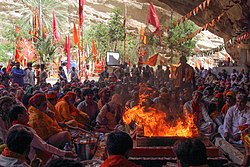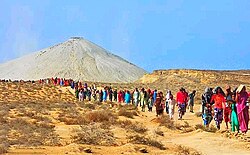Colonial era
During the colonial era, detailed decadal census reports covered Hinduism in the Baluchistan Agency of British India. The 1911 census counted a total of 38,326 Hindus in the province, forming approximately 4.6 percent of the total population. Of the total, 14,985 Hindus (39 percent) belonged to indigenous tribes of the Balochistan region, and 22,617 Hindus (59 percent) were migrants from other regions of the country. [7] : 57
Being a religious minority in the region for centuries, colonial officials found that indigenous Baloch Hindus developed a form of religious syncretism that incorporated many aspects of Islam into their cultures and traditions, greatly differing from the forms of orthodox Hinduism practiced in other parts of the subcontinent. Furthermore, caste and family ancestry was often difficult to ascertain, as Hindus indigenous to the Balochistan region mainly solely identified as a member of their respective Baloch tribe, typically unknowing of their caste background.
"Proverbially elastic though the term is, Hinduism is stretched almost to breaking point in Baluchistan. It is not merely that the Hinduism of the domiciled Hindu families widely different from the Hinduism they see practised among the alien immigrants; there is precious little in their religion that would pass for Hinduism in more enlightened parts of India. It almost looks as if the singular freedom from persecution which the old Hindu families have always enjoyed at the hands of their Musalman over-lords had given Islam greater scope to impart its subtle influence to their inward beliefs and outward practices. Knowing no sacred books but the Sikh scriptures, and with priests (Brahmans though they may be) as ignorant of the Shastras as themselves, these benighted Hindus have allowed nearly all their rites and ceremonies to become coloured with an Islamic tinge. They reverently resort to Muhammadan shrines; they invoke Muhammadan saints; in times of trouble they are glad of the help of charm mongering mullahs. It is not uncommon to find them observing Muhammadan fasts, or participating in the Muharram and other Muhammadan festivals." [7] : 57–58
"The Hindus of Kalat town — undoubtedly among the oldest in the community — claim to be offshoots of the mysterious Sewa dynasty that ruled in Kalat centuries before the Brahui Confederacy took shape. But though the Bhatia of Las Bela punctiliously refer their advent to the year 708 A.D., and the Hindus of Lahri tell in all good faith of their journeyings from Aleppo with Chakar the Rind, the early history of these old Hindu families is hopelessly befogged. Everything, however, seems to point to the western Panjab and Sind as the countries from which most of them came, though isolated families in Nushki may have immigrated by way of Afghanistan, and a few others may have wandered in from the far corners of India. Originally they may have been as diverse as the villages from which they came and the dates of their coming. Today the old Hindu families form a more or less homogeneous community. In particular customs no doubt they vary considerably; but common environment has set its common mark on them all. And it is in the effect of an alien environment on Hindus and Hindu caste that the main interest in these old trading families of Baluchistan is centred." [7] : 175
"Except in Quetta, where the Hindu community has become so overgrown that conditions are abnormal, neither caste nor sub-caste enters into their composition: there is nothing incongruous or unusual in a Panchayat subscribing impartially to a Sikh Dharamsala and to the worship of a Devi or of Darya Pir; or in a Panchayat (like that of Chuharkot in Barkhan) which is composed almost wholly of Aroras having a Brahman as its president. In other words, a Panchayat is a Panchayat not of caste-members but of the whole body of Hindus in a village community. It is indeed almost always sheer waste of time to question a member of one of these old Hindu families regarding his caste. Brahman he knows and Musalman he knows; and it is enough for him that he is neither the one nor the other, but a Hindu pure and simple. Most of the families are undoubtedly Arora; some few are very possibly Khatri; the Bhatia of Las Bela are probably Rajput. But these are distinctions too nice for a local Hindu; it is more than possible that he may never have heard the terms before. Nevertheless, though his mind may be a blank as to the name of his caste, he can sometimes give the name of his sub-caste—possibly a hoary name like Ahuja, possibly a newly coined name like Ramzai or Panjazai, modelled on the name of a tribal section. But it is merely a matter of names after all. The Ramzai and the Panjazai and the Ahuja may have each some cherished peculiarities of their own. But such peculiarities strike no discord between them. The old Hindu families are a brotherhood of equals; among themselves they know no distinctions valid enough to influence the intercourse of everyday life." [7] : 176
The 1921 census counted a total of 51,348 Hindus in Balochistan, forming approximately 6.4 percent of the total population. Hindus belonging to the indigenous tribes of the Balochistan region numbered 17,479 persons and formed 34 percent of the total Hindu population, while migrants from other regions of the country numbered 33,869 persons or 66 percent of the total Hindu population.
The 1931 census counted a total of 53,681 Hindus in Balochistan, forming roughly 6.2 percent of the total population. Hindus associated with the indigenous tribes of the Balochistan region numbered 16,905 persons and formed nearly 31.5 percent of the total Hindu population. Conversely, migrants from other regions of the country numbered 36,776 persons and made up approximately 68.5 percent of the total Hindu population. [8] : 148
After the partition of British India and the ensuing creation of Pakistan, much of the Hindus migrated to India, [9] particularly the Bhagnaris community. [10] [11]




